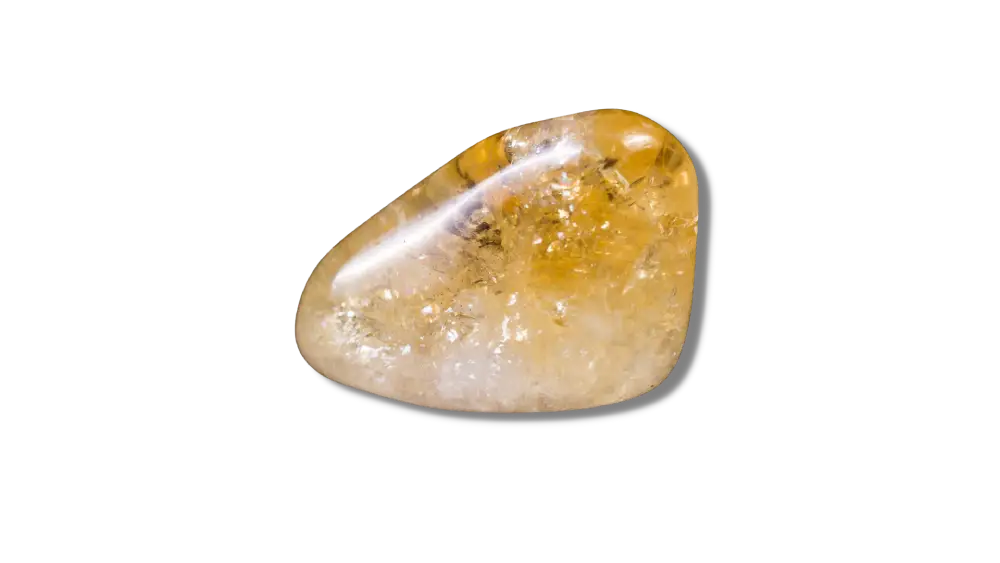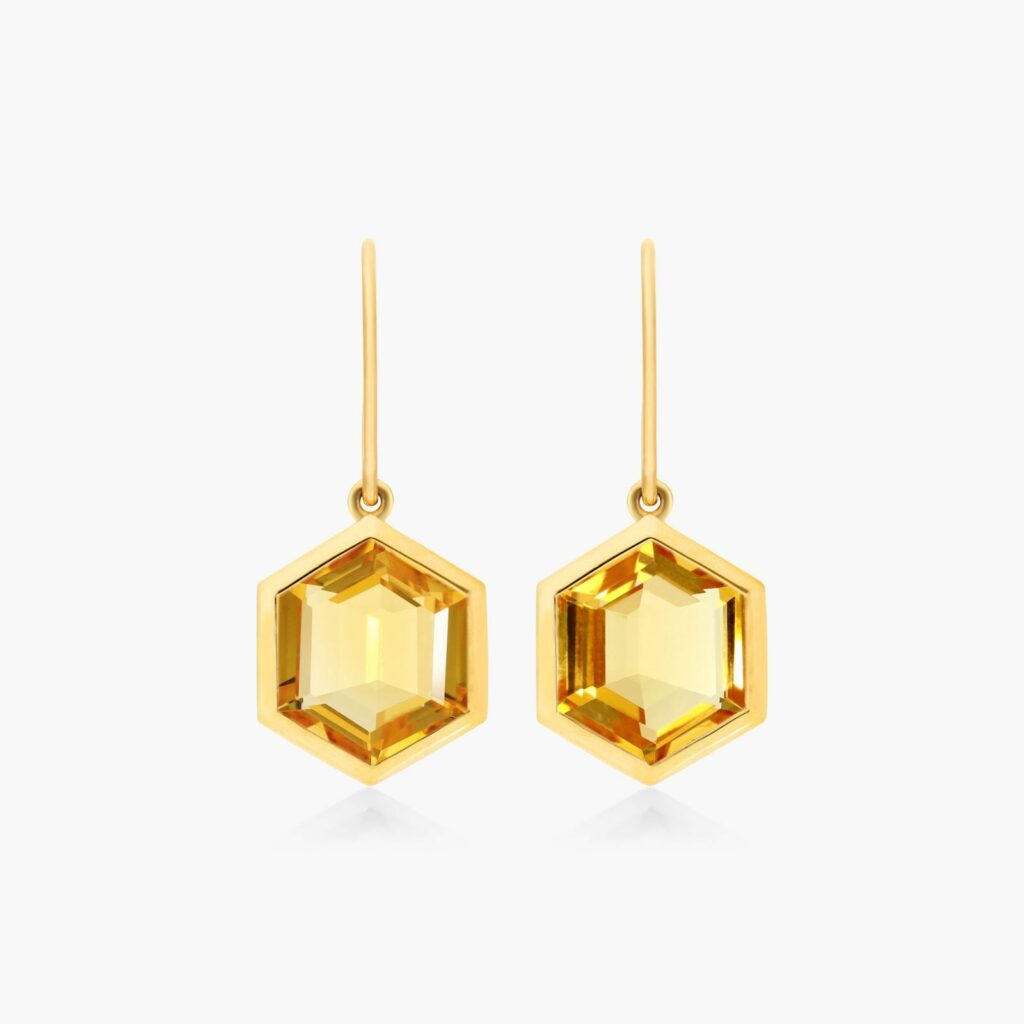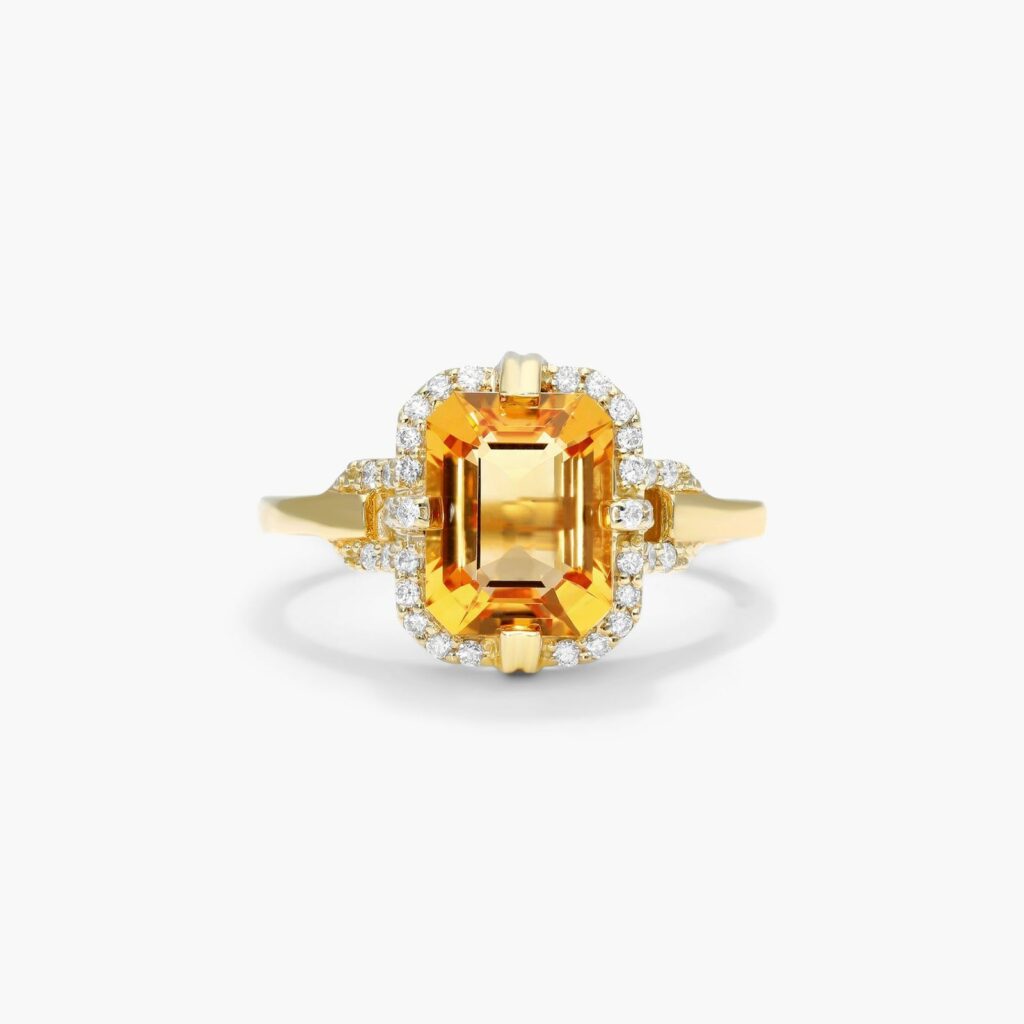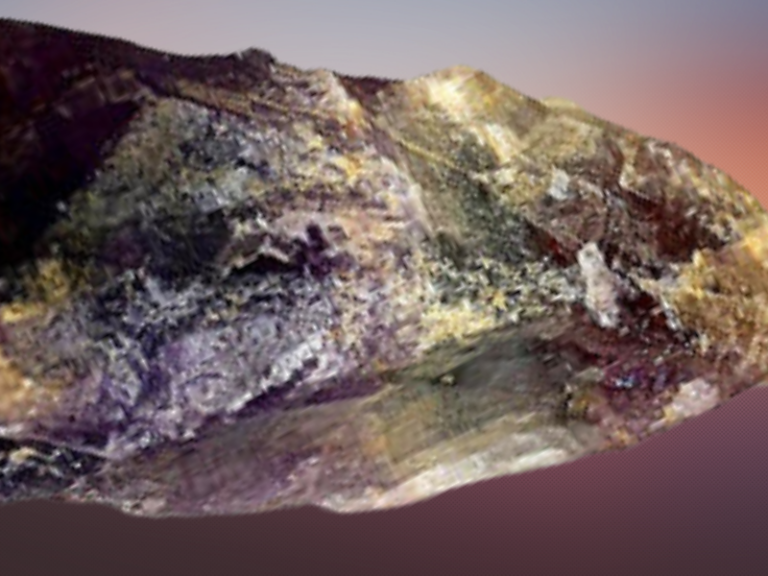Citrine Crystal: Properties, Benefits & Meanings

Citrine Crystal Overview
Citrine crystal is a beautiful stone known in the gemstone community for its manifestation powers. It is composed of quartz crystals that give it a unique yellow-orange coloration.
If you’re looking for information on Citrine, then this guide will help you get started.
What is Citrine Crystal?
Citrine crystal is a beautiful yellow-colored crystal that is the birthstone of November.
The name for this stone is derived from the French word for lemon. Citrine crystals are sometimes said to resemble lemon rinds.
This gem has been known and used since ancient times to promote spiritual growth and healing and attract abundance.
This stone is a variety of Quartz containing iron or manganese in trace amounts (usually less than 1%). The color ranges from pale yellow to brownish orange-yellow to almost opaque honey yellow; many crystals contain internal cloudiness called “bleeding.”
Another name for Citrine is “the merchant’s stone,” owing to its reputation for attracting money and prosperity. In ancient Greece, it was considered an amulet against harm, worn by travelers who would venture out into dangerous places like battlefields or plague-ridden cities to protect themselves from damage or injury.
Citrine Appearance
- Citrine crystal is a member of the quartz family, which includes Amethyst, Smoky Quartz, and clear Quartz.
- Its color ranges from yellow to deep orange, and it has distinct characteristics that make it easy to distinguish from other forms of Quartz.
- Citrine’s color comes from iron impurities in its crystal structure rather than traces of radioactive uranium.
Where Does Citrine Come From?
Citrine crystal is found in many locations across the world, which are as follows:


How Is Citrine Formed?
Citrine crystal is a variety of Quartz found in metamorphic rocks, mainly limestone. It forms in massive veins with other quartz varieties like Amethyst, smoky Quartz, or rose Quartz.
This stone is formed through heat treatment, which means it’s a product of human interaction with nature. This process involves heating Smoky Quartz or an Amethyst in an oven to temperatures between 700-800 degrees Celsius. The heat causes the crystal to lose color, transforming it into a golden yellow stone.
Common Uses Of Citrine
- Citrine crystal has been used as an ornamental jewel since Neolithic times. Additionally, it was one of the most popular stones to use in jewelry during the Art Deco period between 1920 and 1930. It was used for its beauty.
- Citrine crystal is a popular gemstone in many kinds of jewelry, including necklaces, earrings, garnets, and bracelets.
- A piece of Citrine jewelry will surely add a bright note to any outfit. Celebrities, such as Greta Garbo, are known to wear Citrine jewelry because of its beauty.
Physical Properties
It’s essential to understand the physical properties of a gemstone before you start wearing it. For example, the Mohs hardness scale of mineral hardness has a value of 7 for Citrine. Any crystal above a six is considered hard and durable. This means that Citrine crystal cannot be scratched with a simple kitchen knife, and is good for every day wear.
The crystal structure of Citrine is orthorhombic, meaning that its crystals are elongated and rectangular; this is why you may have seen references to “rhombic” or “tabular” crystals when discussing the appearance of other minerals.
The fracture planes in this gem are uneven and unevenly spaced, so when you break it by hitting it with another stone (like Quartz), each piece will have an irregular shape.
This crystal has poor luster—this means that when light hits the surface of this gemstone, minimal reflection occurs back toward your eye (as opposed to, say, diamond which reflects most light). Its refractive index is 1.54-1.56.
| Mineral Group | Quartz |
| Formula | SiO2 |
| Chemical name | Silicon dioxide |
| Color | Various shades of golden yellow and orange. |
| Hardness (Mohs scale) | 7 |
| Refractive Index | 1.54-1.56 |
| Fracture | Conchoidal |
| Luster | Vitreous |
| Specific Gravity | 2.65 |
| Transparency | Transparent to translucent |

Radiant Hexagons: Adorn yourself with James Allen’s 18K Yellow Gold Bezel Hexagonal Citrine Hook Earrings. The warm glow of citrine within sleek hexagonal bezels, a stunning addition to your style.

The Value of Citrine
The value of the Citrine gem, as you might imagine, depends on the size, quality, and cut of the stone. The rarity of this crystal is also crucial to its value.
If you have a Citrine gemstone that measures less than 5 carats (about 1/2 inch in diameter), it will likely be inexpensive and affordable.
A crystal that weighs between 8 and 10 carats can fetch between $4-$10 at wholesale prices. This means that such an opal could be worth anywhere from $32-$100 depending on other factors such as clarity and color saturation (which determines its attractiveness).
As you move up towards 20+ carats in size, the cost goes down—but not by much—and then plateaus after 40+ carats when there are only so many people who can afford these larger stones for their jewelry collection!
Darker shades of Citrine crystal that have a “wooden” or dark orange color are valued more highly. These are often called Madeira Citrine.

How to tell if Citrine is real
There are a few methods to check your crystal for authenticity.
- Scratch Test: If you want to be sure of what you’re buying, the best way is to use a sharp knife to “scratch” your stone. If it’s natural Citrine, it’ll get dark orange or yellow and show some brown material beneath the stone’s surface that resembles rust. This isn’t foolproof because some fake gemstones will still react similarly, but if done correctly, it can hint at whether or not the stone has been treated with something artificial (and, therefore, may not be worth much).
- Acetone Test: Another easy way to test your Citrine is by putting a drop of acetone on its surface: If there’s any shine from polishing agents left on top of your stone after being exposed to this substance for several minutes (it takes time), then chances are pretty good that you have yourself a fake.
- Inclusions: One final way to check for authenticity is to look for any inclusions. Natural gemstones are imperfect and contain various structures in the structure that are known as inclusions. These are not present in artificial gems.

Golden Glamour: James Allen unveils the 18K Yellow Gold Citrine Diamond Halo Ring. Embrace the warmth of citrine surrounded by a dazzling diamond halo, a testament to elegance and beauty.

Chakra Connection
Citrine crystal is connected to the Solar Plexus Chakra, located at the center of your body, below the navel, and above the genitals on each side of your spine (you can find it easily by placing both palms on either side of your back). The Solar Plexus Chakra represents personal power, self-esteem, independence; creativity; vitality; connection with others; confidence in decision making, intuition, etc.
Yellow Citrine also has a minor connection to the Sacral Chakra, which is located below the navel.
Furthermore, the Citrine stone is the birthstone of November.
What Are the Benefits of Using Citrine?
Creates Positive Outlook on Life
Citrine is the gem that can help you cultivate positive energy, which can positively affect personal and professional relationships. It also has been said to increase the positivity in the household.
This optimistic energy is believed to be contagious, so if you wear citrine jewelry around others, they will pick up on it and start feeling more optimistic as well. As a result, you’ll be able to find opportunities where others see none.
In addition, because of its ability to help you look at things from different perspectives, Citrine can help you spot potential solutions in situations where other people would only see problems.
Gem Of Abundance
Citrine is the gem of abundance. Its color comes from the presence of iron, which makes it a standard yellow color. It’s also thought that Citrine can help with self-esteem and confidence while promoting generosity and sharing.
Citrine is an excellent stone for manifestation because it has an energy that promotes prosperity, good luck, and abundance. This makes it very useful to people who want to attract money into their lives or change their financial situation.
Citrine will help you attract more money into your life by opening up the channels between you and the Divine, helping you step into your power as a co-creator with God (or Goddess).
Calms fears and jealousy
Others say that it can calm fears and jealousy as well as help relieve depression and anxiety by helping you focus on things that are going right rather than wrong in your life. It is also a stone of optimism and can help you see things’ positive side.
Citrine is an excellent stone for sharing good fortune with others, so if you have been fortunate or have achieved something significant, Citrine can help you share it with those around you.
Increases Energy Levels
Citrine crystal is believed to help increase energy levels, and that’s just one of its many benefits.
It is said to increases libido in bed, increases your energy in the workspace, and even gives you a much-needed boost in the early morning so you can get a wonderful start to your day.

How to Clean Citrine Jewelry
Here are some steps that will help keep your Citrine jewelry looking beautiful.
- One way to easily cleanse your Citrine crystal is by running it under a gentle stream of lukewarm water.
- Soak the stained area in warm water and scrub it gently with a soft toothbrush until all traces of the stain have disappeared.
- Place a microfiber cloth onto your crystal’s surface and gently rub, moving in slow circles.
- Cleanse it with burning sage leaves to banish negative energy and make the gem more peaceful.
- To recharge your stone, you can immerse it in moonlight or bury it underground for at least six hours—but overnight is best.
Citrine should be protected from harsh chemicals and extreme heat, which could damage it.
Experts do not recommend steam cleaning, so it is best to keep your jewelry away from them. Furthermore, Ultrasonic cleaners are also not preferred.
FAQs
Is Citrine a birthstone?
Yes! Citrine is the birthstone for November. It is also a traditional gift for the 40th and 45th anniversaries.
Is Citrine Heat Treated?
Citrine is formed when smoky Quartz is heat-treated. However, it is also made by using heat-treated Amethyst. Some people don’t like heat-treated Citrine and only want natural stones in their collection, but Citrine is a natural stone. Heat-treated Citrine occurs naturally within the Earth’s mantle. However, humans also heat treat smoky Quartz and amethysts to create this crystal.
What Are The Healing Properties Of Citrine?
Because the color of Citrine crystal varies a lot, some people believe the stone has healing properties that can assist you in achieving balance and clarity in your life. Citrine has healing properties for your physical body, as well as your emotions and thoughts. It allows you to release negative energies and thoughts holding you back from being happy and successful in life. It also helps to bring clarity to your mind so that you can make better decisions about what you want out of life.
What is Citrine good for?
If you are looking for a crystal to help heal both your physical body as well as your emotions, then Citrine is a good choice because it balances both sides of yourself equally so that they work together harmoniously instead of against each other as they usually do. It increases your sense of self and helps you overcome negative emotions like self-doubt and anxiety.
According to the principles of feng shui, you should place your Citrine in the South-East corner of your living area to utilize it properly.
Which Gemstones Go Best With Citrine?
Citrine looks excellent with many gemstones, especially Emerald, Sapphire, Ruby, and Topaz. However, for the best spiritual pairing, you will want an Ametrine, a type of Agate, an Amethyst, or an Aquamarine gemstone as their abilities complement those of a Citrine. Other orange and yellow gemstones, such as Carnelian, also go well with this crystal and amplify each other’s abilities.







